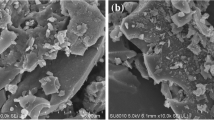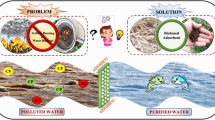Abstract
The montan resin (MR) is a solid waste produced during the industrial process of refined montan wax from lignite, and usually disposed by landfill and incineration, which easily cause environmental pollution and resource waste. Based its physicochemical properties, our study attempted to modify MR by Bacillus benzoevorans to achieve ecological utilization of MR. As results, the weight loss rate of MR, expressed as modification degree, was found to increase with the increase of B. benzoevorans-incubated time. The apparent oil–water partition coefficient (Kow), used to evaluate the improvement on hydrophilicity of MR, significantly increased (P < 0.01) after modification. IR analysis showed the functional groups of –OH and C=O in modified MR were more than those in MR. Meanwhile, comparison of the chemical changes between MR and modified MR by relatively quantitative analysis of gas chromatography–mass spectrometry (GC-MS) revealed that the content of some chemical components in the latter decreased, and the newly appeared chemical components all had more oxygen-containing functional groups. The bioactivity of the modified MR in agricultural application was evaluated regarding germination and seedling growth of maize seed preliminarly. Compared with the original MR-treated group, the modified MR showed an obvious effect on promoting the growth and germination of maize.






Similar content being viewed by others
References
Dong, H. F., Yun, Z. J., & Cao, Y. F. (2008). Comprehensive utilization way and prospect of China lignite. Coal Technology, 27, 122–124.
Lu, B., & Tang, Y. Q. (1999). Study on composition of resin from brown coal wax biomarker compounds. Journal of Fuel Chemistry and Technology, 3, 262–267.
Shen, G. J., Zhang, M. X., & Wang, L. G. (2005). On the utilization route of lignite. Coal Processing and Comprehensive Utilization, 6, 25–27.
Li, B. C., Yuan, C., & Qin, Y. (2014). Research progress on combined bleaching of peracetic acid and hydrogen peroxide. Journal of Kunming University of Science and Technology, 39(3), 94–97.
Ikeda, M., & Yamakawa, K. (2008). Induction of multiple granulomas in the liver with severe hepatocyte damage by montan wax, a natural food additive, in a 90-day toxicity study in F344 rats. Food and Chemical Toxicology, 46(2), 654–661.
Huang, Y., Zhang, M., & Zhang, H. F. (2017). Study on chemical modification of lignite wax resin by different oxidation systems. Journal of Kunming University of Science and Technology, 2, 95–98.
Yao, L. K., & Tang, Y. Q. (2002). Chemical study of some separators in Shulan brown coal resin component. Journal of Fuel Chemistry and Technology, 30(1), 86–88.
Li, B. C., & Bu, Y. S. (2000). Chemical composition and structural characteristics of free acid in lignite resin. Journal of Fuel Chemistry and Technology, 28(2), 162–169.
Li, B. C., Dai, Y. Z., & Zhang, H. F. (1999). Chemical composition and structural characteristics of montan resin hydrocarbon. Journal of Fuel Chemistry and Technology, 27(1), 80–90.
Li, B. C., & Zhang, J. (2004). Chemical composition and distribution characteristics of lignite resin alcohol. Journal of Kunming University of Science and Technology, 29(3), 82–90.
Li, B. C., & Zhang, H. F. (1999). Refinement of brown coal waxes from Yunnan province by oxidation of Na2Cr2O7.2H2O and H2SO4. Journal of Fuel Chemistry and Technology, 27, 277–281.
Liu, J. X., Zhang, M., & Li, B. C. (2016). Assessment of montan resin on germination and growth of wheat seed. Agricultural Research, 5(1), 98–103.
Wang, W. Y., Dong, T., & Ma, X. P. (2014). Orthogonal experimental study on microbial degradation of phenol. Environmental Science and Management, 39(8), 57–60.
Tian, L., & Zhong, J. J. (2000). Research progress on microbial degradation of organic pollutants. Industrial Microbiology, 30, 46–50.
Joshi, C., Mathur, P., & Khare, S. K. (2011). Degradation of phorbol esters by pseudomonas aeruginosa psea during solid-state fermentation of deoiled jatropha curcas seed cake. Bioresource Technology, 102(7), 4815–4819.
Wan, C. H., Chen, J., & Zhu, Y. H. (2013). Study on adsorption property of the biomodified rice straw on Azure A in simulated wastewater. Journal of Anhui Agricultural Sciences, 41, 2637–2639.
Poopathi, S., & Abidha, S. (2007). Use of feather-based culture media for the production of mosquitocidal bacteria. Biological Control, 43(1), 49–55.
Pichinoty, F. (1983). Isolation of a large aerobic sporulated sheathed bacteria from soil by elective culture. Annals of Microbiology, 134B, 443–446.
Pichinoty, F., & Asselineau, J. (1984). Morphology and cytology of Bacillus benzoevorans, a new filamentous, sheathed mesophilic species, degrading various aromatic acids and phenols. Annals of Microbiology, 135B, 199–207.
Pichinoty, F., Asselineau, J., & Mandel, M. (1984). Biochemical characterization of Bacillus benzoevorans sp. nov., a new filamentous, sheathed mesophilic species, degrading various aromatic acids and phenols. Annals of Microbiology, 135B, 209–217.
Lanzhou University. (2010). Organic chemistry experiments. China: Higher Education Press.
Jin, Y. Y., Zhang, J. S., & Zhang, Y. (2004). Studies on the intestinal absorption of crocin in rats and determination of the partition coefficient. Journal of China Pharmaceutical University, 35, 247–257.
Ding, L., Zhao, J., & Zhang, J. S. (1997). The preformulation study of acyclovir. Shandong Pharmaceutical Industry, 6, 1–3.
Wang, Q. W., Mei, Q. B., & Liu, X. Y. (2003). Determination of physical and chemical constants of genistein. Chinese Journal of Hospital Pharmacy, 23, 729–730.
Wu, M. M., Fu, M. Z., & Song, X. P. (2010). Determination of the oil-water partition coefficient of hymecromone by uv spectrophotometry. Journal of Anhui Agricultural Sciences, 38, 11985–11986.
Yuan, C., Qin, Y., & Zhang, M. (2015). A new method of testing and evaluating the quality of refined montan wax: digital Color and GC fingerprint. Chromatographia, 78, 1–10.
Hoagland, D. R., & Amon, D. I. (1950). The water-culture method for growing plants without soil circular. California Agricultural Experiment Station Circular, 347, 1–32.
Mei, X., Lin, D. H., & Xu, Y. (2009). Effects of phenanthrene on chemical composition and enzyme activity in fresh tea leaves. Food Chemistry, 115(2), 569–573.
Shao, K. (2012). Effects of salt stress on seed germination of wheat. Education Science, 18, 66–68.
Funding
The research was supported partially by the National Natural Science Foundation of China (No. 21466018) and Scientific Research Foundation of Yunnan Provincial Department of Education (No. 2017ZZX131).
Author information
Authors and Affiliations
Corresponding author
Ethics declarations
Conflict of Interest
The authors declare that they have no conflicts of interest.
Additional information
Publisher’s Note
Springer Nature remains neutral with regard to jurisdictional claims in published maps and institutional affiliations.
Rights and permissions
About this article
Cite this article
Wang, H., Qin, Y., Li, B. et al. Biological Modification of Montan Resin from Lignite by Bacillus benzoevorans. Appl Biochem Biotechnol 188, 965–976 (2019). https://doi.org/10.1007/s12010-019-02962-x
Received:
Accepted:
Published:
Issue Date:
DOI: https://doi.org/10.1007/s12010-019-02962-x




